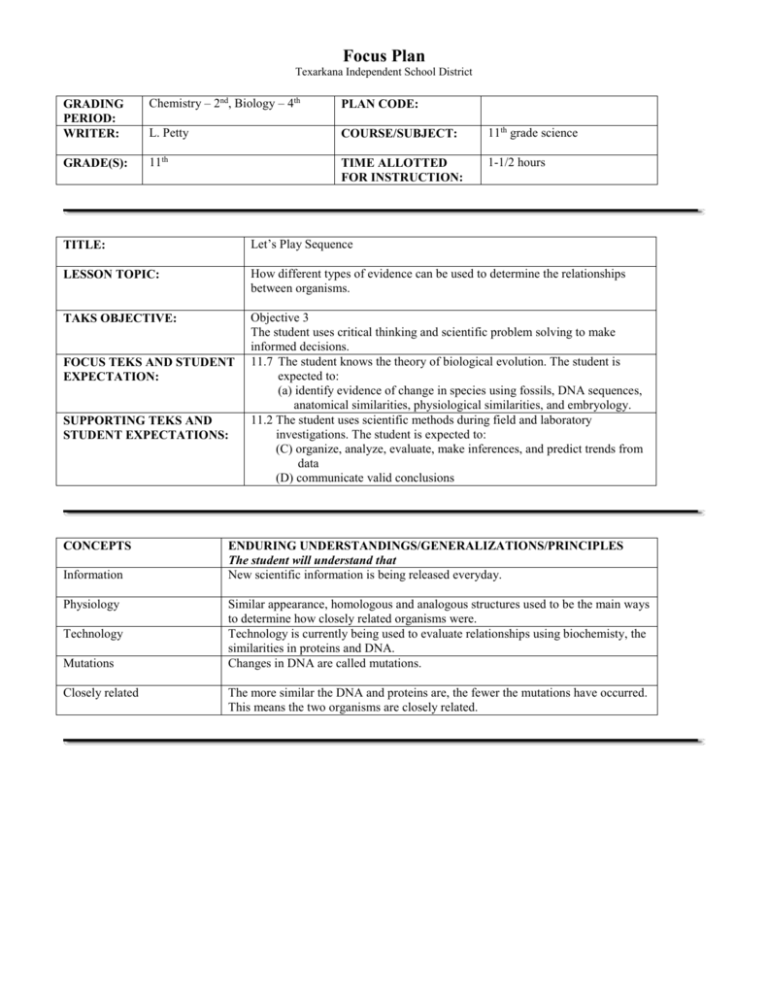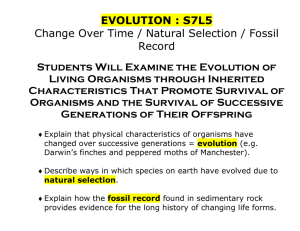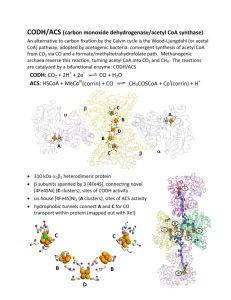11.7A Let`s Play Sequence - Texarkana Independent School
advertisement

Focus Plan Texarkana Independent School District GRADING PERIOD: WRITER: Chemistry – 2nd, Biology – 4th PLAN CODE: L. Petty COURSE/SUBJECT: 11th grade science GRADE(S): 11th TIME ALLOTTED FOR INSTRUCTION: 1-1/2 hours TITLE: Let’s Play Sequence LESSON TOPIC: How different types of evidence can be used to determine the relationships between organisms. TAKS OBJECTIVE: Objective 3 The student uses critical thinking and scientific problem solving to make informed decisions. 11.7 The student knows the theory of biological evolution. The student is expected to: (a) identify evidence of change in species using fossils, DNA sequences, anatomical similarities, physiological similarities, and embryology. 11.2 The student uses scientific methods during field and laboratory investigations. The student is expected to: (C) organize, analyze, evaluate, make inferences, and predict trends from data (D) communicate valid conclusions FOCUS TEKS AND STUDENT EXPECTATION: SUPPORTING TEKS AND STUDENT EXPECTATIONS: CONCEPTS Information Physiology Technology Mutations Closely related ENDURING UNDERSTANDINGS/GENERALIZATIONS/PRINCIPLES The student will understand that New scientific information is being released everyday. Similar appearance, homologous and analogous structures used to be the main ways to determine how closely related organisms were. Technology is currently being used to evaluate relationships using biochemisty, the similarities in proteins and DNA. Changes in DNA are called mutations. The more similar the DNA and proteins are, the fewer the mutations have occurred. This means the two organisms are closely related. I. SEQUENCE OF ACTIVITIES (INSTRUCTIONAL STRATEGIES) A. Focus/connections/anticipatory set Once students are seated, put Transparency Master: Fossil Evidence on the overhead. Go over the questions with students. Explain that fossil evidence like this, along with the appearance of the organisms, used to be our main methods of determining the relative age and relationship among organisms. We are now using biochemical evidence to determine relationships. B. Instructional activities (demonstrations, lectures, examples, hands-on experiences, role play, active learning experience, art, music, modeling, discussion, reading, listening, viewing, etc.) 1. Lecture Go over the Pre-lab Discussion information provided in the lab. C. Guided activity or strategy Go through the comparison of the human and the chimpanzee using Figure 2. Show students how to record the information on Data Table 1. D. Accommodations/modifications Students requiring accommodations may be assigned a peer tutor. E. Enrichment Students requiring enrichment may be assigned as a peer tutor. II. STUDENT PERFORMANCE A. Description Complete Lab Worksheet – Let’s Play Sequence B. Accommodations/modifications Students requiring accommodations should be assigned a peer tutor for the procedure part of the activity. C. Enrichment Students requiring enrichment should be assigned to help struggling students, especially in filling in data. III. ASSESSMENT OF ACTIVITIES A. Description Grade Lab Worksheet – Let’s Play Sequence B. Rubrics/grading criteria Data Tables and Graphs should be graded at 10 points each. Incorrect or missing information would cause a point deduction. Lab questions should be graded at 4 points each. C. Accommodations/modifications Students requiring accommodations may need additional help with questions 6 and 9, which are upper-level questions. The Bonus question may be optional. D. Enrichment All students requiring enrichment must do all questions on their own. E. Sample discussion questions 1. What are amino acids? The building blocks of proteins. 2. Where does the pattern for amino acids come from? The pattern of the DNA. 3. Using biochemical evidence, how can scientists determine how closely related organisms are? The more similar the proteins/DNA, the more similar the organisms. 4. What causes a difference in DNA? Mutations 5. What can cause mutations? Chemicals, errors in DNA replication, x-rays, radiation from the sun, etc. IV. TAKS PREPARATION A. Transition to TAKS context Use the following information to answer questions 1-4. A. cys B. cys C. cys try val try try his ala val met val val cys his ala met ala his met his met try met 1. How many differences occur between organisms A and B? (a) 4 (b) 5 (c) 9 (d) 10 2. Which two organisms are the most closely related? (a) A and B (b) B and C (c) A and C (d) they are all equally related 3. Which two organisms would probably look the most alike? (a) A and B (b) B and C (c) A and C (d) none of the organisms would look alike 4. Which two organisms would probably have similar proteins? (a) A and B (b) B and C (c) A and C (d) none of them would have similar proteins ala ala his cys cys cys cys pro pro met ala met B. Sample TAKS questions Spring 2003 1. The table shows a comparison of some amino acids found in cytochrome c. The two organisms in the table that are most closely related are _____. (a) Q and T (b) R and S (c) Q and R (d) Q and S Spring 2004 2. The table shows an amino acid comparison of cytochrome c, a protein involved in cellular respiration in aerobic organisms. The two organisms in the table that are least genetically related are the __________. (a) silkworm moth and the fruit fly (b) silkworm moth and the screwworm fly (c) fruit fly and the screwworm fly (d) fruit fly and the hornworm moth V. KEY VOCABULARY Amino Acid Analogous DNA Evolution Fossil VI. RESOURCES A. Textbook None needed. Homologous Mutation Protein Sedimentary rock B. Supplementary materials/equipment Transparency Master – Fossil Evidence Instructor’s Copy – Transparency Master Fossil Evidence Lab Worksheet – Let’s Play Sequence Instructor’s Copy – Let’s Play Sequence C. VII. Technology FOLLOW UP ACTIVITIES (reteaching, cross-curricular support, technology activities, next lesson in sequence, etc.) A. Reteaching Go over lab questions. B. Next lesson in sequence Biology and Chemistry – Objective 7B – natural selection Geology – radioactive dating or other fossil evidence VIII. TEACHER NOTES Before lab: 1. Make a copy of the Transparency Master – Fossil Evidence 2. Run off a copy of the lab for each student. During lab: 3. The only problem students may have during the lab is confusion on where to fill in data. There are a lot of figures, data tables and graphs. Spot check to make sure students are filling in each correctly.








